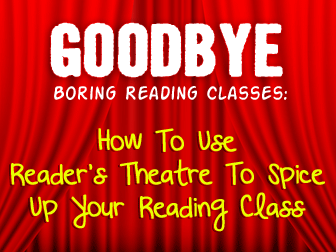
Reading is one of the most essential skills to teach language learners; however, if you’ve ever been in a reading classroom, you know that reading can also be one of the skills students are least motivated to learn, especially low-proficiency students.
Students who struggle with reading grow to resent reading time and avoid reading in English at all costs. Fortunately, it doesn’t have to be this way.
Reader’s theatre is a fantastic way to increase motivation for students of all ages. What is reader’s theatre? It’s a reading strategy that drives students deeper into the text and gets them to read it multiple times. Students read a text, create a script based on the text, and then read it aloud with expressive voice, motions, and any other theatre elements you would like to include. The main benefits of this strategy are that it lowers students’ affective filter by encouraging them to produce language in a non-threatening way, improves reading fluency through repeated exposure to the text, and increases their motivation by giving them a real purpose for reading. Reader’s theatre requires no props and very minimal set-up; ideal for any teacher! Here are some tips for using reader’s theatre in your class.

How to Use Reader’s Theatre To Spice Up Your Reading Class
-
1
Break Students into Groups
As with any collaborative learning activity, it’s best if the groups are teacher-selected. Pair high-achieving students with lower-achieving students so that they can help encourage one another. Based on your knowledge of your students, try to put at least one enthusiastic or outgoing student in each group. This student will help to encourage the other shyer students come out of their shell while reading aloud.
-
2
Create a Script Based on an Appropriate Text
Choose a text that your students have been reading that would make a good script. It doesn’t have to be the entire text; just a portion would be enough, especially for the first time you do the activity. If the texts you’re reading with your students wouldn’t make appropriate theatre pieces, picture books are also ideal. Students of any level can be creative in coming up with a dialogue that uses vocabulary appropriate for their level. With picture books, the options are endless!
It might be helpful the first time you do this activity with your class if you write the script. This will allow students to focus on the expressive reading and give students a better idea of what reader’s theatre is. The next time you do the activity, they will be better informed as to what a script should look like.
With your student groups, you can either have all of the groups do the same text or give them each a different text. If you give each group the same text, it can be interesting to see the different variety of scripts and approaches to the performance that your students come up with. You can also make it a competition to see who has the most creative performance. Alternatively, you can give each group a different text. This works best when you split up a longer text and have each group do different sections of the same novel or story.
-
3
Model
As the teacher, the students look to you for an example of what you expect from them. Before doing reader’s theatre, read aloud to your students and model expressive reading. Demonstrate how to adjust your voice for different emotions, and how you can change your pronunciation and word stress to convey additional meaning.
-
4
Mark the Scripts
Show students how to annotate and make notes on their script for emotion, intonation, stress, and inflection. Go from group to group and help them with their first few lines and then allow them to practice doing it on their own. Marking the text encourages a deeper comprehension of the story by understanding the speaker’s emotions and purpose. This exercise also helps reinforce natural pronunciation patterns that are important for students to learn.
-
5
Practice, Practice, Practice
The primary objective of reader’s theatre is not to turn your students into Oscar winners but to have them read a text again and again and again. This repeated exposure reinforces the vocabulary and sentence structure that your students are learning. By frequently revisiting the text, students are also improving their reading fluency. Marking and performing the script also helps to reinforce the main idea of the text, a difficult reading skill to teach.
By using reader’s theatre, you are giving students a very clear purpose for reading: they are going to put on a performance. With this objective in mind, they are more highly motivated to continue reading a text even though they have read it many times before. Remind your students that they don’t have to memorize their lines; that may happen incidentally, but their goal is to practice reading from the page.
-
6
Optional Props
Some of the best reader’s theatre performances have been those where students simply sit on chairs in a row in front of the audience with nothing but their scripts. By limiting the visual aids, students must rely on their voices and expressive reading to convey the story’s meaning to the audience. Students in the audience are also challenged to rely on their listening comprehension and vocabulary knowledge to understand the story.
Depending on your time and resources, you can incorporate props into the performance. By correctly utilizing props, students are engaging the text on a deeper level and indicating a thorough knowledge of the story and character they are portraying.
-
7
Perform for an Audience
Whenever possible, gather an audience for your students. Whether it’s an administrator with a few spare minutes, another class that comes to visit, or the students from the other groups within your own class, having an audience gives the students additional motivation and purpose to do their best work.
Regardless of the age or proficiency level or your students, your class can benefit from reader’s theatre.
The adaptability of reader’s theatre makes it easy to modify the activity to fit any lesson plan time frame or context. After completing the activity with your students over time, you will see improvements in their reading fluency and comprehension skills. Most of all, it’s a fun way to build a cooperative environment in your classroom while building students’ reading proficiency.
P.S. If you enjoyed this article, please help spread it by clicking one of those sharing buttons below. And if you are interested in more, you should follow our Facebook page where we share more about creative, non-boring ways to teach English.







